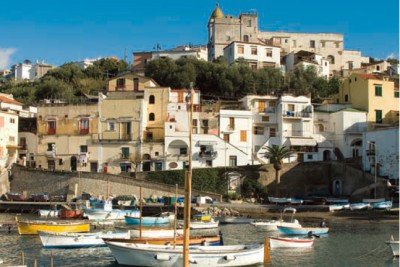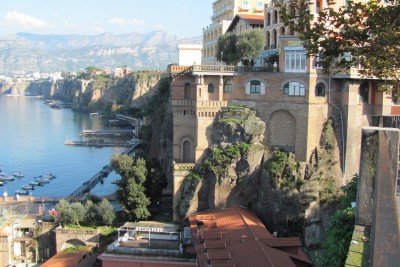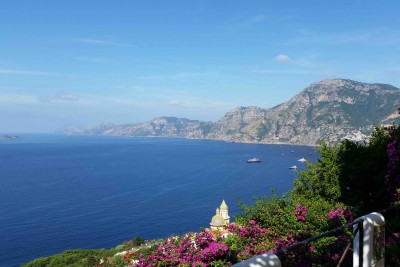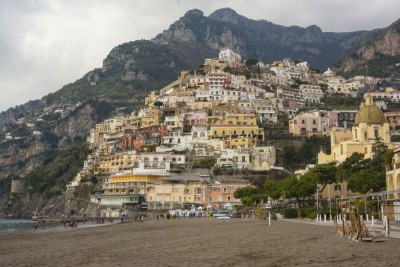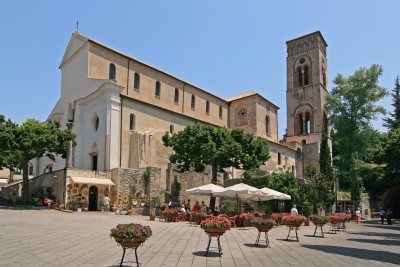Our Insider Guide to Sorrento
A beautiful terrace on the Gulf of Naples and Mt Vesuvius










Just across the Bay from Naples lies the Sorrentine Peninsula. Looking out over the Bay of Naples, Mount Vesuvius, and the Isle of Capri, Sorrento has a great setting and much to offer its visitors beside its famous lemons and limoncello liquor.
A popular resort town for the Romans since the beginning of the empire, Sorrento is known for its gardens, its Cathedral, or Duomo, and in general the old section of town, a wonderful place to get lost in its narrow streets and alleyways with colorful shops and quaint trattorias.
The main cultural institution of the town is the Museo Correale (#1 on the map), housed in a building that belonged to the noble family of the Correales, who donated it along with their collections (via Correale, 48; tel. 081/878.18.46; opening hours: from Wednesday to Monday, 9.30 A.M. - 1.30 P.M.; closed on Tuesday and national holidays).
 Museo Correale
Museo Correale
The museum is one of the most imposing palazzi of Sorrento, with a splendid depressed arch portal, which enhance a façade elegantly enriched with ornamental double lancet windows with pointed arches in dark tuff and a gorgeous large ogival window.
On the ground floor furniture and local crafts, archaeological finds of Greek, Roman and medieval origin mostly taken from religious buildings in Sorrento (two 4th century B.C. fragments of Artemis on a deer; a celebrated base of Augustus (second and 3rd century A.C.), Attic pottery found during the excavation of local necropolis and various other ancient objects, including some of prehistoric times.
On the first floor there is a collection of paintings and decorative art from the 16th, 17h and 18th centuries, with paintings by Neapolitan and Flemish artists (including a splendid interior of the Cathedral by Abel Grimmer); finely decorated furniture, and a collection of Bohemian crystal and Venetian glass. On the second floor are paintings by the Neapolitan artists from the 18th and the 19th centuries, including still lives and landscapes of Sorrento, Naples, Pompeii and Herculaneum.
In the attic is a collection of ceramics from Naples and Marseille and in the main hall, a collection of 18th and 19th century porcelain sorted by geographical origin (Italy, Germany, Austria , France, the Netherlands , Denmark, Switzerland, England and Russia).
The adjoining garden, of ancient origin, has been improved over the centuries.
Via Correale leads to Piazza Tasso (#2), which in ancient times was at the edge of the urban area but is now considered the historic center of the town.
 Piazza Tasso
Piazza Tasso
Along the north side of the square, a terrace overlooks the Gulf of Naples. If you are looking for a spot to just chill and relax for a bit, we suggest a table at one of the cafés on the Piazza.
From the west side of Piazza Tasso is corso Italia with its elegant 19th century buildings on both sides.
Going up a few steps to the left of the Corso, one arrives at via Pietà (#3), with some of the oldest buildings in town.

Via della Pietà
Among them, two of the most interesting examples of local architecture, Palazzo Correale (first half of the 14th century) and Palazzo Veniero (#4), a 13h century building of late Byzantine and Arabic taste (the rage at the time in the South of Italy), with a large arch-shaped windows decorated with strips of yellow and grey tuff alternating with geometrical patterns of unusual beauty.
 Palazzo Veniero
Palazzo Veniero
Through an underpass, via Pietà leads to the Duomo, or Cattedrale dei Santi Filippo e Giacomo (#5), with its beautiful clock tower.

Duomo
Of ancient origin, the Duomo has been rebuilt over the centuries. The façade, which was destroyed by a cyclone in 1904, was rebuilt in 1924 with marble facing.
In the apse there is a 19th century choir, a masterpiece of the local art of inlay. Under the pulpit, a small and significant altar piece by Silvestro Buono (1573), known as La Vergine tra San Giovanni Battista e san Giovanni Evangelista; (The Virgin between St. John the Baptist and St John the Evangelist); next to the baptismal font, Sacrificio del Sangue di Cristo (Sacrifice of the Blood of Christ) (1522) and 12 splendid 14th century panels; in the chapel of the Sacrament, on the 17th c. altar, a wooden 15th century Crucifix.

On the right, the secondary entrance has an elegant rectangular portal dating back to 1478.
To the right of the entrance, on a swivel hinge, there is a 10th century marble slab with a depiction of a lioness.
In the first chapel on the right there is a baptismal font where Italian writer Torquato Tasso was baptized.
From Corso Italia continuing along via Tasso, the ancient center of the Greek-Roman town, turning right onto via San Cesareo one reaches piazzetta Padre Reginaldo Giuliani, known for Sedile Dominova (#6).

Sedile Dominova
This elegant 15th century building with a loggia open on two sides with round arches and topped by a 17th century dome covered in elegant yellow and green majolica riggiole (hand-decorated tiles), represented the center of the lives of the aristocratic and administrative life of the area.
Turning into via Luigi De Maio one arrives in piazza Sant’Antonino, with its the Conservatorio di Santa Maria delle Grazie (#7).
 Conservatorio di Santa Maria delle Grazie
Conservatorio di Santa Maria delle Grazie
Inside the Conservatorio there are well executed canvases by painters who worked on the Costiera (Buono, Malinconico, Caracciolo, Corenzio), and typical elements of a cloistered convent such as the choir to the tribunes or the wooden shutters made to protect the nuns’ privacy.
The floral majolicated floor is very beautiful, on white worked enamel to give an unusual “glass-effect”.
Also in the piazza is the Palazzo Municipale, or Municipal Palace, formerly a convent, and the Basilica of Sant'Antonino (#8).

Sant'Antonino
Dating back to the High Middle Ages, around the year 1000, this Basilica shows significant and evident elements from temples or ancient building (for instance, the shafts of Roman type columns). Inside, a lovely 18h century crib; in the crypt, the votive offerings testify to popular religiosity and faith in the Patron Saint.
The interior of the Basilica is divided by ancient marble columns into three naves. From the aisles, going down a double marble staircase, is the Crypt, rebuilt in 1753, whose vaults rest on ancient columns. Under the central altar is the tomb of St. Antonino; on the smaller altar, on the right, is a small 16th century wooden crucifix with silver, and on the left a 15th century fresco of the Madonna and Child.
From piazza S. Antonino, via De Maio leads to the seaport, Marina Piccola (#9), where ferries and hydrofoils depart for Capri and Naples.
 Marina Piccola
Marina Piccola
Via Bernardina Donnorso leads into piazza Francesco Saverio Gargiulo, with the Chiesa di San Francesco (#10), or Church of St. Francis.
 St, Francis, or San Francesco
St, Francis, or San Francesco
The original convent dates back to the mid 8th century.
The architecture of the mystical and atmospheric Cloister (16th century), has crossed arches in tuff on two sides of the portico, while the other two sides have round arches on octagonal pillars, and a harmonious collection of elements from pagan temples, such as the three corner columns.

Chiostro di San Francesco
Next to the convent, the 16th century church houses a 17th century wooden statue of the Saint from Assisi next to the crucified Christ.
The Chiesa e Monastero di San Paolo (#11) is a 9th century Benedictine complex.
 San Paolo, interior
San Paolo, interior
Characterized on the outside by a bell tower (with a majolicated cupola), it serves as a belvedere. Inside the church, decorations, stuccos, majolicated floor and 18th century paintings.
The road that leaves piazza della Vittoria goes down to Marina Grande (#12), a quaint fishing village with beach concessions and restaurants.

Marina Grande
Shopping in Sorrento can be a fun and enjoyable way to spend an afternoon.
Visitors will find a wide variety of small shops offering everything from leather goods and ceramics to jewelry, locally grown fruits and vegetables, and anything lemon. Corso Italia is the main roadway through town. Whether you are looking for something particular or just browsing it’s a great way to discover the heart of Sorrento and get a flavor for this small community.

ALSO
The Porta di Parsano (#13), opened in 1745 within the old town walls that had defended the town since Greek times.
 Porta di Parsano
Porta di Parsano
The Porta della Marina Grande (#14, Via Marina Grande) was the oldest of Sorrento’s gates. Up to the 15th century it was the only access to the town from the sea.

Porta di Marina Grande
The Casa di Cornelia Tasso (#15, on via San Nicola) has a noble portal with flat ashlar above which sits a heraldic coat of arms. It is the house of the sister of Torquato Tasso, the great poet from Sorrento, who also stayed here for some time. His parental home, in Via Vittorio Veneto, is now part of the Imperial Tramontano hotel.

La Casa di Cornelia Tasso
The Chiesa dei Servi di Maria (#16) was finished in the 18th century. Its Baroque interior has three wooden statues: a Cristo Morto (Dead Christ), carried in procession through the streets during the rites of Good Friday, and two 15th century pieces a Madonna and a San Giuseppe (St Joseph).

Chiesa dei Servi di Maria
The Chiesa dell'Addolorata (#17), built in the 18th century, has a Baroque façade in tufa stone. The interior has two unusual altars in the same material. On the altar there is a wooden sculpture of the Vergine Addolorata (Our Lady of Sorrows) to whom the temple is dedicated.

Chiesa dell'Addolorata
The Chiesa della Santissima Annunziata (#18), built in the 18th century, has an elegant façade in tufa stone. On this very spot, in ancient times there was a pagan temple dedicated to Cibelis. When Christianity took over, the cult of the eastern pagan “Mother of all gods” was exchanged for the Catholic Virgin and Mother. Inside, on the ceiling, is a paiting of a Madonna and Child handing her sacred belt to St Augustine and St Monica (18th century). Also inside a beautiful wooden Crucifix (17th century); a 18th century altar in polychrome marbles with the statue of the Madonna della Consolazione (Mother of Consolation) and numerous 18th century canvases. The sacristy has an interesting late 16th century Annunciazione.
 Santissima Annunziata
Santissima Annunziata
The Chiesa del Carmine (#19), built in the 16th century, in the Baroque style. The interior has one nave, dedicated to the Black Madonna of the Neapolitan church with the same name. Inside, there are 17h and 18th century canvases and 17th century reliquaries in inlaid wood.
 Santa Maria del Carmine
Santa Maria del Carmine
The Excelsior Vittoria Hotel (#20) was built on an ancient Imperial Roman Villa. It is famous among classical music fans because in 1921 the tenor Enrico Caruso spent here the last troubled months of his life. His room, the holy of holies for music lovers and fans, is still kept exactly as he left it.
 Excelsior Vittoria
Excelsior Vittoria
The ruins of Villa Pollio Felice and Bagni di Regina Giovanna (#21, on Via Capo di Sorrento) are the fascinating remains of a majestic Roman villa, complete with landing stages, terraces and cisterns, which the poet Stazio attributed to Pollius Felix, historian and patron of the Arts, protector of Virgil and Horace. Next to the ruins there is a naturally protected pool of water protected by a natural arc and an ancient Roman nymphaeum nicknamed Bagni di regina Giovanna by locals after the exuberant noblewoman Giovanna Durazzo d’Angiò.
 Villa Pollio Felice
Villa Pollio Felice
The Museo-Bottega dell'Intarsia Lignea, (#22), or Museum-Workshop of Wooden Intarsia at Palazzo Pomarici Santomasi, (Via San Nicola, 28 - Tel. 081/877.19.42; Opening Hours: from Monday to Saturday: 10 A.M.-1:30 P.M., 3 P.M.-6 P.M. Sunday visits may be booked). In a splendid 8th century palazzo, the structure houses a historic collection of 19th century furniture and objects that sheds light on the technique of inlay and in particular the unique Sorrento intarsia.

Museo dell'Intarsio
For printing our Sorrento Guide (facing pages) you can download the PDF by clicking HERE
For offline reading on your smartphone or tablet, you can download the PDF of our Sorrento Guide (single page) by clicking HERE
If you have an Android OS, you will find it in your Download app.
If you have an iPhone or an iPad, open and save it in iBook (free app).
Watch a video on Sorrento
Watch Rick Steves' video on Sorrento

